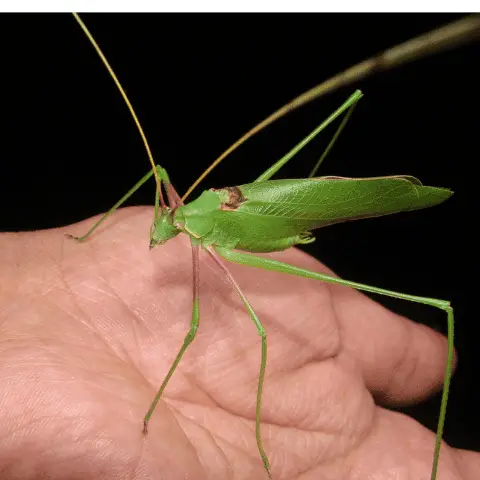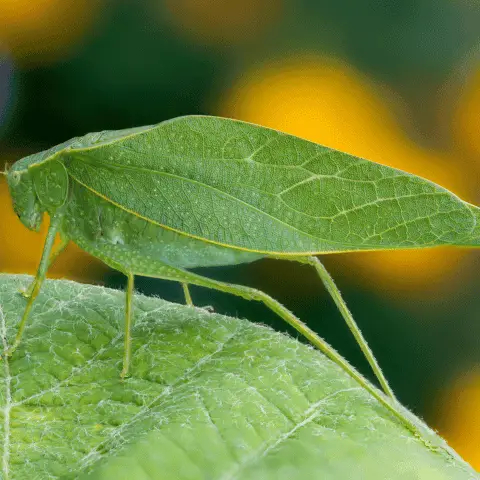Have you ever come across a green bug that looks like a leaf while exploring your garden? Chances are, you may have encountered a katydid bug, better known as bush cricket. These fascinating insects are masters of camouflage, blending in seamlessly with their surroundings to avoid predators. In this blog post, we will delve into the world of katydids, exploring their physical appearance, role in the ecosystem, and dispelling common misconceptions about these unique creatures.
What are Katydid Bugs (aka Bush Crickets)?
Katydid bugs are known for their striking resemblance to leaves, with their long antennae and wings mimicking the veins and edges of a leaf. Their green coloration helps them blend in perfectly with foliage, making them difficult to spot by predators such as birds and lizards. In addition to their leaf-like appearance, katydids also have large hind legs that allow them to jump great distances when needed.

One of the most intriguing aspects of leaf bugs is their size, which can vary depending on the species. While some katydids are relatively small, measuring around 1-2 inches in length, others can grow much larger, with some species reaching up to 6 inches long. Despite their size differences, all leaf bugs share the common trait of having flattened bodies that enhance their leaf-like disguise.
One of the most distinguishing features of bush crickets is their powerful hind legs, which allow them to jump great distances. While they may not be as strong flyers as other insects like bees or butterflies, bush crickets do indeed have the ability to take flight. Bush crickets are not built for speed or long-distance travel in the air, but rather use flight as a means of escaping predators or moving between plants in search of food or mates.
In addition to their impressive camouflage skills, leaf bugs are also known for their unique behaviors. These insects are primarily nocturnal and feed on a diet consisting mainly of leaves. They use their powerful jaws to chew through plant material and extract nutrients. Interestingly, some species of katydids are also capable of producing sounds by rubbing their wings together—a behavior used for communication and mating purposes.
Are katydid bugs dangerous for your garden?
Despite their intimidating appearance, katydid bugs are usually harmless to plants. While katydids can be considered herbivores, they are not typically regarded as harmful garden pests. In fact, some gardeners even consider them beneficial as they help pollinate and control population of other insect pests by preying on them.
One concern that some gardeners may have about katydid bugs is their voracious appetite for foliage. While it’s true that these insects can consume a significant amount of plant material, they are unlikely to cause severe damage to healthy plants in a well-established garden. In most cases, the presence of katydids in your garden should not be cause for alarm and can even be seen as a sign of a healthy ecosystem.
Are Katydid Bugs Dangerous to Humans?
Contrary to popular belief, katydids do not pose any harm to humans and are generally docile creatures that prefer to avoid confrontation.
These insects are herbivores, feeding primarily on leaves and plant matter. They do not have the ability to bite or sting humans, making them relatively harmless in terms of direct physical harm. However, like all insects, Katydid bugs do have the potential to carry pathogens or diseases that could be harmful if transmitted to humans through contact. It is always best to avoid handling insects directly and wash your hands thoroughly after coming into contact with them.

Despite their non-threatening nature, some people may still feel uncomfortable around Katydid bugs due to their appearance or behavior. These insects have a unique defense mechanism where they produce a loud clicking sound by rubbing their wings together when threatened. While this may startle some people, it is simply a way for the bugs to communicate with each other and deter predators. Understanding this behavior can help alleviate any fears or misconceptions about Katydid bugs.
Are Bush Crickets and Crickets the Same?
When it comes to insects, many different species can easily be confused with one another. One common mix-up is between katydid bugs (bush crickets) and crickets. While they may seem similar at first glance, there are actually some key differences between the two.
To start, let’s talk about appearances. Both bush crickets and crickets belong to the order Orthoptera, which also includes grasshoppers and locusts. However, bush crickets tend to have longer antennae compared to crickets. Additionally, katydid bugs often have wings that are wider than their bodies, while crickets typically have narrow wings that lie flat against their bodies. These subtle differences in appearance can help you distinguish between the two insects.
Another important distinction between bush crickets and crickets is their habitat preferences. Bush crickets are aptly named for their preference for living in bushes, trees, or other vegetation. They are known for their ability to camouflage themselves among leaves and branches. On the other hand, crickets are more likely to be found in grassy areas or near buildings. They are also known for their distinctive chirping sound that is often associated with warm summer nights.
In terms of behavior, both bush crickets and crickets are nocturnal insects, meaning they are most active during the night. However, they have different feeding habits. Bush crickets are omnivorous creatures that feed on a variety of plant material as well as small insects. Crickets, on the other hand, primarily feed on plant matter such as leaves and seeds. This difference in diet can impact where you might find these insects in your garden or backyard.
Conclusion
In conclusion, while katydid bugs may startle you with their leaf-like appearance, they are fascinating creatures that play an important role in the ecosystem. By understanding more about these unique insects and debunking common myths surrounding them, we can appreciate the beauty and complexity of nature’s creations. So next time you spot a green bug that looks like a leaf in your garden, take a moment to marvel at the wonders of the natural world around us.
Some of the links above are affiliate links, meaning at no additional cost to you, I will earn a commission if you click through and make a purchase.
Articles you might be interested in:

